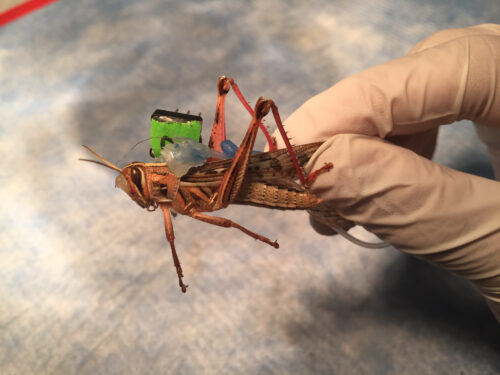Image Courtesy of Baranidharan Raman.
Have you ever considered hijacking an insect? While this may seem like an absurd idea, the notion of exploiting an organism for its biological attributes is not all that foreign. Take, for instance, the use of canaries in coal mines during the 1900s. The canary acquires oxygen both when it inhales and exhales, and this double dose of air results in the bird’s increased vulnerability to carbon monoxide and other poisonous gases. Thus, the health of the canary provided a means for coal miners to understand the safety of their environment.
Professor of Biomedical Engineering Baranidharan Raman and colleagues at the Washington University in St. Louis aim to harness nature’s incredible biology for a different purpose: hijacking the locust olfactory system to engineer bomb-sniffing insects. “Through evolutionary processes, biology has come up with these amazing small-molecule detectors that are present in your nose, my nose, as well as locusts,” Raman said. In locusts, the approximately fifty thousand olfactory receptor neurons (ORNs) of each antenna convert odorants into neural signals that funnel into the antennal lobe. “Why not use the insect as a sensor, tap into the neural signals while the insect is interacting with the environment, and use those neural signals to understand whether chemical A or chemical B is present?” Raman asked.
In previous work, the researchers implanted electrodes to record neural signals in the antennal lobe, and they demonstrated that those neural responses provide a fingerprint to discern between explosive and non-explosive vapors in addition to different types of explosive vapors. In a recent study published in PNAS, Raman and his team investigated how locusts recognize a particular odorant regardless of stimulus history, dynamics, and context. “You can smell coffee in a coffee shop, grocery shop, or restaurant. It smells the same whether you are on the coast or in the driest of the Sahara Desert,” Raman said. The same is true for locusts, but how?
In the presence of an odorant, neural signals from ORNs of the antenna drive the activity of cholinergic projection neurons (PNs) and GABAergic local neurons (LNs) of the antennal lobe. PNs and LNs reformat the signal, resulting in intricate spiking patterns among PN ensembles. Those PN patterns encode odor intensity and identity. To test the locust’s invariant stimulus recognition ability, the researchers conditioned the insects through methods resembling that of Russian physiologist Ivan Pavlov. In the presence of a food reward, locusts automatically open their sensory maxillary palps. After the presentation of an odorant followed by a food reward in six training trials, the locusts learned to open their maxillary palps in response to the odorant alone.
Raman and colleagues examined changes in palp opening—an indicator of odorant recognition—in response to perturbations including varied stimulus dynamics, altered stimulus history, the existence of competing cues, and differences in ambient conditions. The results support the hypothesis that locusts detect an odor regardless of such perturbations. “Now we know the behavior is stable. How stable are the neural responses?” Raman questioned. The researchers recorded the activity of antennal lobe PNs and found much variability in odor-evoked firing for single-neurons and cell ensembles. “There was no single feature that was reliable and robust that allowed this percept of an odor to remain constant independent of all these perturbations,” Raman said.
To decode the neural responses, Raman and colleagues used a linear classifier. The classifier assigns a weight to each neuron and successfully predicts the presence of an odor if the sum of weighted neurons exceeds a threshold value. Investigating why the classifier works, they discovered two different ensembles of neurons in the locust olfactory system: ON neurons, active in the presence of the stimulus, and OFF neurons, active in the absence of the stimulus. The classifier assigns positive weights to the ON neurons and negative weights to the OFF neurons. “When you combine the activity of all the ON neurons while subtracting the activity of the OFF neurons, if that sum is above a certain threshold value, the odor is present. Simple as that,” Raman said. In fact, a classification scheme using only ternary weights—positive one for ON neurons, zero for non-responders, and negative one for OFF neurons—enables robust odor recognition.
Uncovering more of locust olfaction through the study of ON and OFF neurons, Raman and his team are one step closer to exploiting biology’s expertise to hijack the insect olfactory system. Next time you try to squash a bug, look closer. Bomb-sniffing insects are an innovation of the near future.

